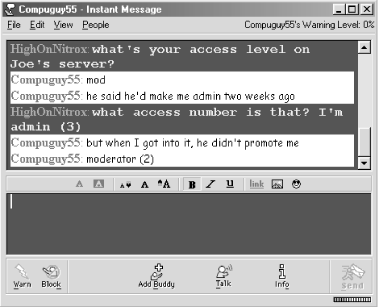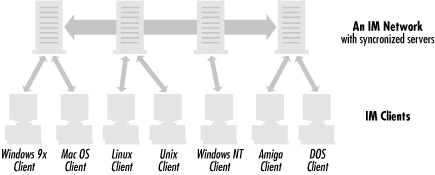7.1 Introduction to Instant Messaging
7.1 Introduction to Instant Messaging Instant Messaging (IM) is real-time communications and is popularly known as chat . Instant Messaging allows a person to type a message, send it, and have it viewed a second later by one person or thousands of people. Most computer platforms contain some variation on the theme. The most popular Internet chat program is AOL's Instant Messenger Some IM systems allow users to create lists of people who they would like to chat with (often called buddy lists ). When a user logs on to their computer, the IM client can be configured to alert the other users on the buddy list that the participant is available to chat. Conversely, IM will alert the user when her buddies sign on. Participants can be invited to chat with one another. Some IM conversations can be viewed by anyone logged in (a public channel ) while other chats are private , invitation -only affairs. The default type depends on the IM type and client. Figure 7-1 shows AOL's Instant Messenger Figure 7-1. AOL's Instant Messenger Email is a store-and-forward model of messaging. You type a message and send it. The message is copied to a mail server where it is sent through a series of other intermediate mail servers (unless the recipient is on same mail server) until it reaches its eventual destination. There it waits until the recipient opens or downloads the message with their email client. With Instant Messaging, as soon as you hit your Enter key, your message is broadcast to all the intended recipients as fast as the network can transmit data. It's a great way to send short messages or hold informal conversations without exchanging multiple emails. 7.1.1 Types of Instant Messaging NetworksAll IM clients allow users to chat, but sophisticated versions also allow file sharing, private chats, Internet telephony, radio channels, video cams, online gaming, real-time work collaboration, and even email. Instant Messaging is becoming more than typing messages, and as it does, so does its importance within our culture and corporate environments. Although Microsoft's most popular IM client is MSN Messenger, a creative virtual world is used with their V-Chat product. Everyone is represented by a customizable computerized representation called an avatar . Avatars wander around in chat areas and engage in virtual conversations while gesturing and providing other visual clues that cannot be typed. Most Instant Messaging networks operate under two models: peer-to-peer and peer-to-server . In a peer-to-peer model, instant messages sent from one client are broadcast across the network and intercepted by the destination client software. This model only works well on small local networks. The most popular model incorporates messaging servers that keep track of users and rout messages to and from the source and destination. On the larger, more complex IM networks, groups of servers within a network communicate with each other by distributing the load of messages and dividing tasks (see Figure 7-2). This requires that the messaging servers stay synchronized with minimal interruptions. Figure 7-2. Peer-to-server instant messaging network Many IM networks have peer-to-server topologies, but allow peer-to-peer connections. Individual users can initiate private conversations and file transfers between clients, leaving the server component out all together. 7.1.2 Mobile MessagingA hot feature many IM vendors are adding is mobile messaging , which allows wireless PDAs and cell phones to interface with IM networks. There are many mobile phone network standards that allow text and data to be sent and received by participating devices. Thus, a user can send an instant message to a user's PDA or cell phone and receive a response. |
| | |
| Team-Fly |
| Top |
EAN: 2147483647
Pages: 176
